HIDDEN HERITAGE
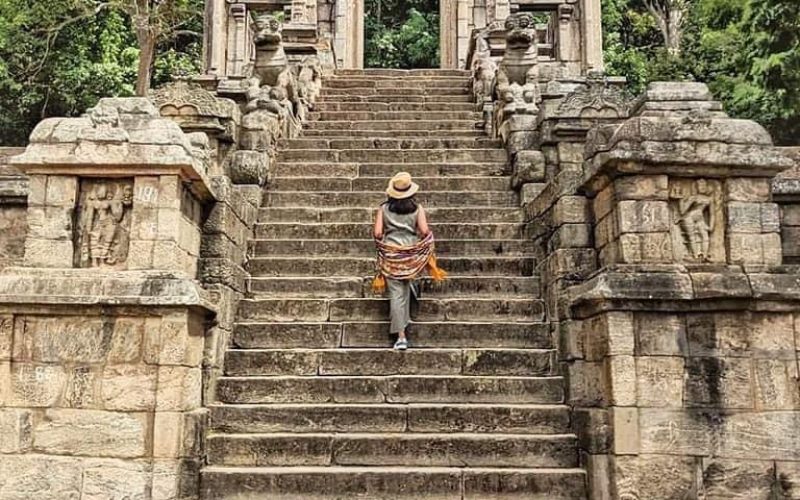

Yapahuwa
Yapahuwa was one of the ephemeral capitals of 13th century medieval Sri Lanka. It’s built around a huge granite rock rising abruptly almost a hundred meters above the surrounding lowlands, it was built as a palace and military stronghold against foreign invaders. Many traces of ancient battle defenses can still be seen, but perhaps its ornamental stairway is its biggest showpiece. On top of the rock are the remains of a stupa, a Bodhi tree enclosure, and a rock shelter cave used by Buddhist monks, indicating that earlier this site was used as a Buddhist monastery, like many boulders and hills in the area. There are several caves at the base of the rock and in one of them there is a shrine with Buddha images.
- North Western Province
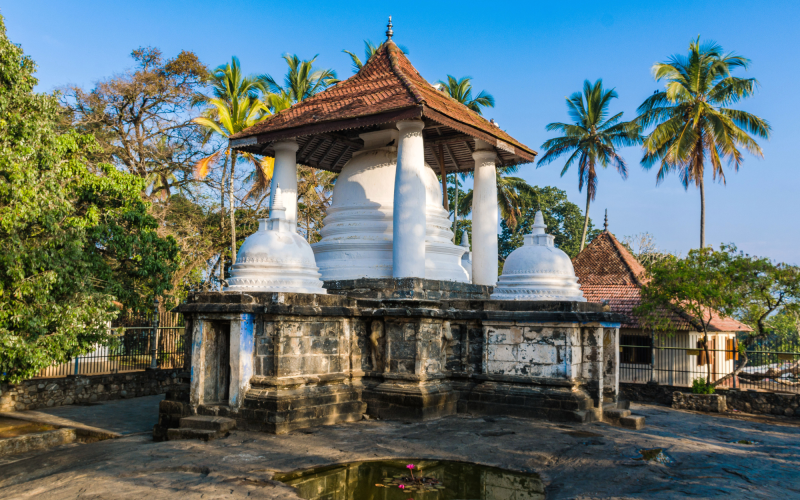

Gadaladeniya Temple
Gadaladeniya Temple was built in during the 14th century during the time of the Gampola
Kingdom. At the entrance you can see the stupa by your right hand side. Actually this
consists of one main stupa and four small ones. The main stupa is covered with a roof. There are four small shrine rooms around it, each surmounted by a small stupa . The main shrine room has a seated Buddha Statue under a dragon arch and four standing Buddha images. The Gadaladeniya Temple also contains a beautifully painted giant wooden chest holding paintings and sculptures of great historical and artistic importance. The Bo tree is located in front of the stupa and there is an old inscription located by it and now protected by a fence to prevent damage.
- Central Province
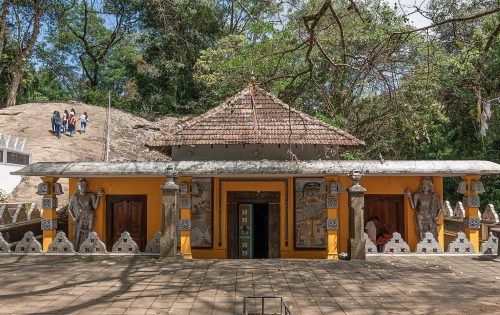

Dowa Rock Temple
Dowa rock temple thought to be built during the reign of King Walagamba in the 1st
century BC. This temple has gained popularity mainly due a huge unfinished Buddha image
carved out of granite boulder which is well hidden from the main road. It has been built
safely inside a ring of mountains, where a beautiful river flows across the plateau. Hence, the area had earned the name, Dowa . But this temple also hides some secrets that time has forgotten. At the rear of the image house is a small stupa inside a cave. Behind this stupa, is a tunnel called the Ravana cave guarded by a figure of a Clay King Cobra. The
Image house built inside the cave is full of colorful murals and Buddha Images and consists of 3 chambers.
- Uva Province
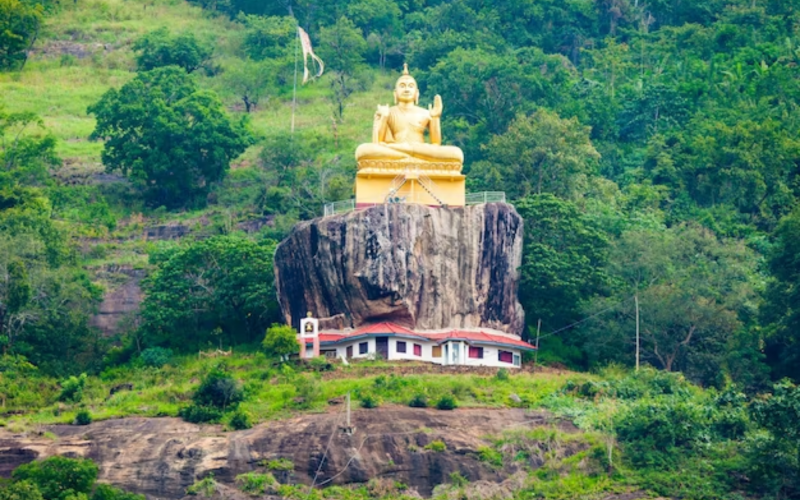

Aluvihare Rock Temple
The Aluvihare Rock Temple was founded by King Devanampiya Tissa of Sri Lanka around the 3rd century BC, functioning as one of the main temples in Sri Lanka that he used to assist in the introduction of Buddhism to his kingdom. The significance of the temple is an original piece of the Buddhist Pali Canon, which was first written completely in text on to Ola (palm) leaves. Aluvihare has many monastery caves, with ancient inscriptions, comparatively modern wall and ceiling paintings with images of the Buddha. The main cave has a 10m long reclining statue of the Buddha, together with standing and seated images. If you climb up to the dagoba on top of the rock just beyond the cave temples, you can enjoy the excellent views and dramatic topography of the North Central Province
- Central Province
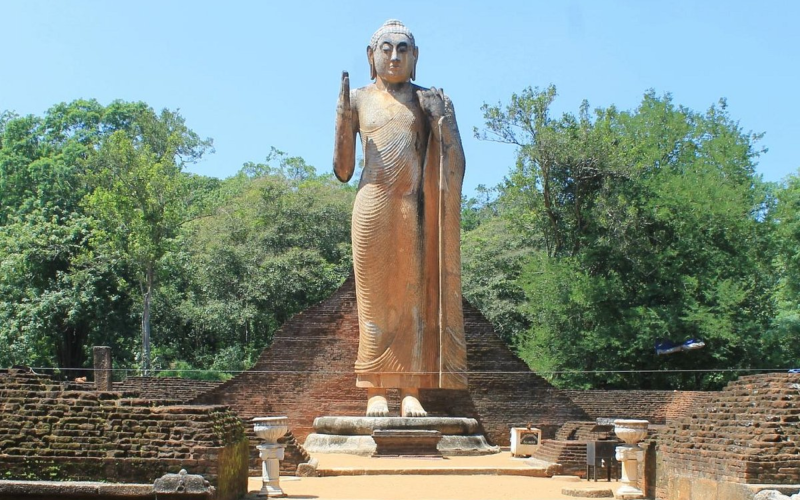

Maligawila Buddha Statue
Maligawila Buddha statue is a standing figure of the Buddha having been carved out of a
large limestone rock during the 7th century by a Prince named Aggabodhi. This statue is
carved out of a single limestone rock and stands about 14.5 meters high. This is the tallest free standing Buddha image in the country however by the time it had been found in 1951 it was already broken into several pieces. But in 1980 the statue was reconstructed and raised again and now the Maligawila Buddha statue attracts a large number of pilgrims every year. About 500 meters away from this is another image carved from rock. This is thought to be the image of the Maithree Natha Bodhisattva also sometimes identified as Avalokithswara Bodhisattva.
- Uva Province
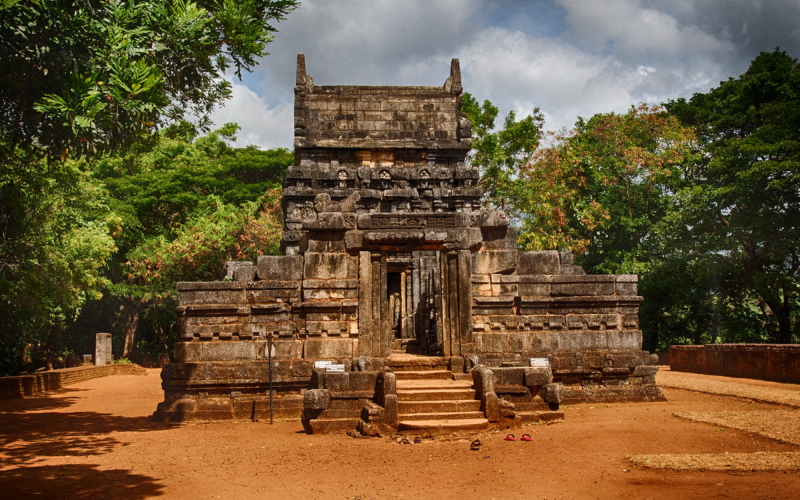

Nalanda Gedige Temple
Nalanda Gedige is a symbol, a hybrid of Buddhist and Hindu architecture. Some of the design elements are distinctly Hindu, such as the mandapa or hall of waiting. But there is no sign of Hindu gods in this architecture. There are erotic but eroded Tantric Buddhist carvings, it exhibits a composite style of architecture unique in Sri Lanka, and Nalanda is named after the great Buddhist University at Nalanda in India. It is surprising that there exists only limited knowledge of this shrine and also its location at Nalanda remains a mystery. The date of construction varies from the 7th to 11th centuries AD. This was a period of great chaos on the island, with South Indian kings establishing themselves in the wake of the decline of the Sinhalese monarchy.
- Central Province
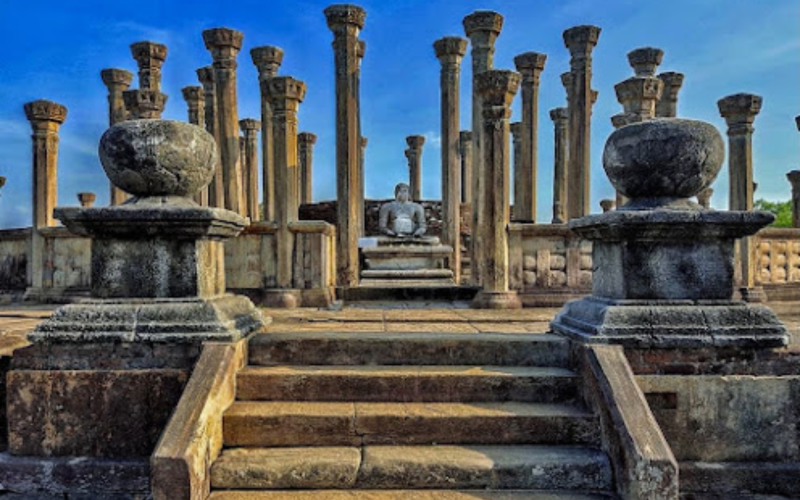

Medirigiriya Vatadage
The circular building known as a vatadage was constructed to house and protect a dagoba built to enshrine the sacred relics of the Buddha. Madirigiriya vatadage is beautifully situated. The surroundings have a history going way back into pre Christian times. The brami characters found on the bricks and some of the stone carvings are an indication of the long history of this site. Vatadage at Madirigiriya is built on a small rock with the entrance on the northern side. At the bottom of the staircase is a massive stone frame, 9’9” feet high and 4’9” feet wide. Make your way upwards an after climbing 27 stone steps you will reach a resting area. The roof of the Stupa house has been built upon three
concentric circles of stone pillars most of which are still be seen in their original state. The inner most circle of 16 pillars are 17 feet in height and the other two circles are 16 and 9 feet in height and 20 and 32 in numbers respectively. Now this place provides a fascinating glimpse of what this temple would have looked like…. over 1000 years ago.
- North Central Province
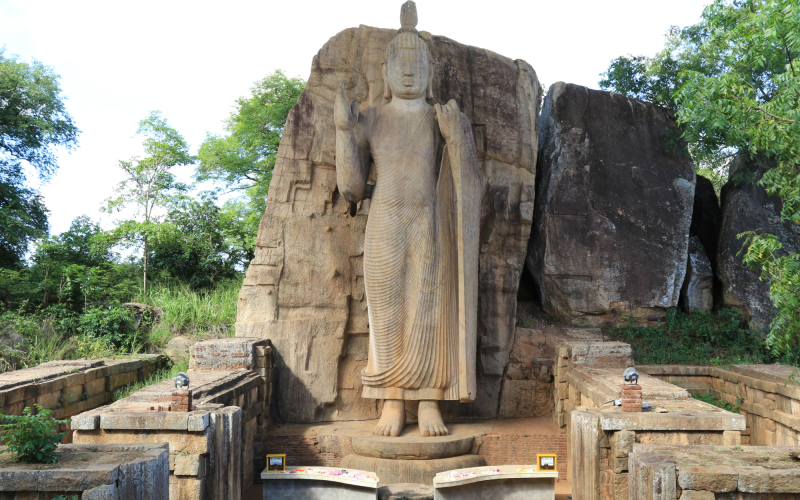

Aukana Buddha Statue
Aukana Buddha is home to the most perfectly preserved ancient statue in Sri Lanka. The perfect & elegant 12m high standing Buddha is adored all over the island to such an extent, that several full scale copies have been erected in the island. Aukana statue is in the “Asisa Mudra”, the blessing position, with the right hand turned sideways to the viewer. The figure is carved in the round, yet narrowly connected at the rear to the rock. Carved out of the living rock with supreme assurance, Aukana Buddha is a magnificent image. His expression is serene & from his curled hair there sprouts the flame called siraspata signifying the power of supreme enlightenment. Although the statue is large & stands straight up with the feet firmly planted on the lotus stone pedestal, the body retains a graceful quality enhanced by beautifully flowing drapery clinging to the body.
- North Central Province
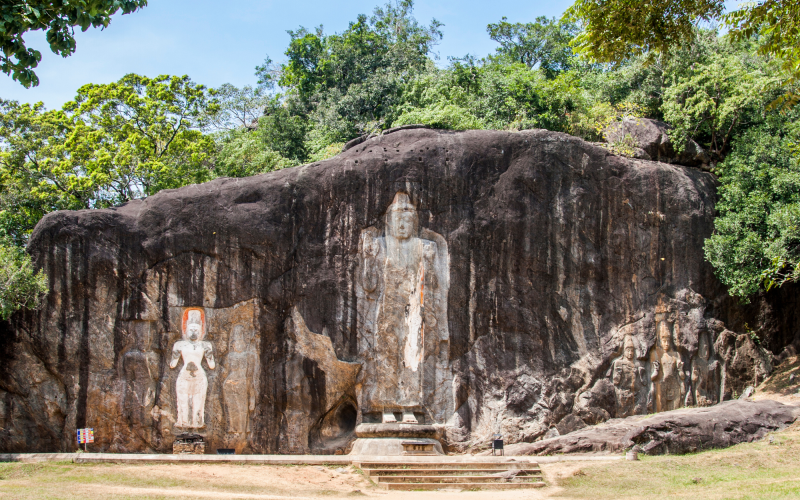

Buduruwagala
The name Buduruwagala means “the rock with the statue of Buddha” And this is exactly what it is. The complex consists of seven statues and belongs to the Mahayana school of thought with a massive 51 foot Buddha statue in the Abhaya Mudra gesture at the centre. The rock itself has shape of a kneeling elephant. The statues date back to the 10th
century. This Gigantic Buddha statue still bears traces of its original stuccoed robe and a long streak of orange suggests it was once brightly painted. Central of the three figures to the Buddha’s right is thought to be the Buddhist mythological figure the Bodhisattva
Avalokitesvara. The female figure to his left, in low relief and in the typical thrice bent
posture is Tara Devi; the figure to the right of Avalokitesvara is Prince Sudhana. He is also
in the typical thrice bent posture. The central figure in the group of three to the Buddha’s
left is Maithri Bodhisattva, the fifth Buddha of this eon. The figure has a crown,
ornamentations and a robe. To his left is Vajrapani who is holding the hourglass shaped Tibetan thunderbolt
- Uva Province
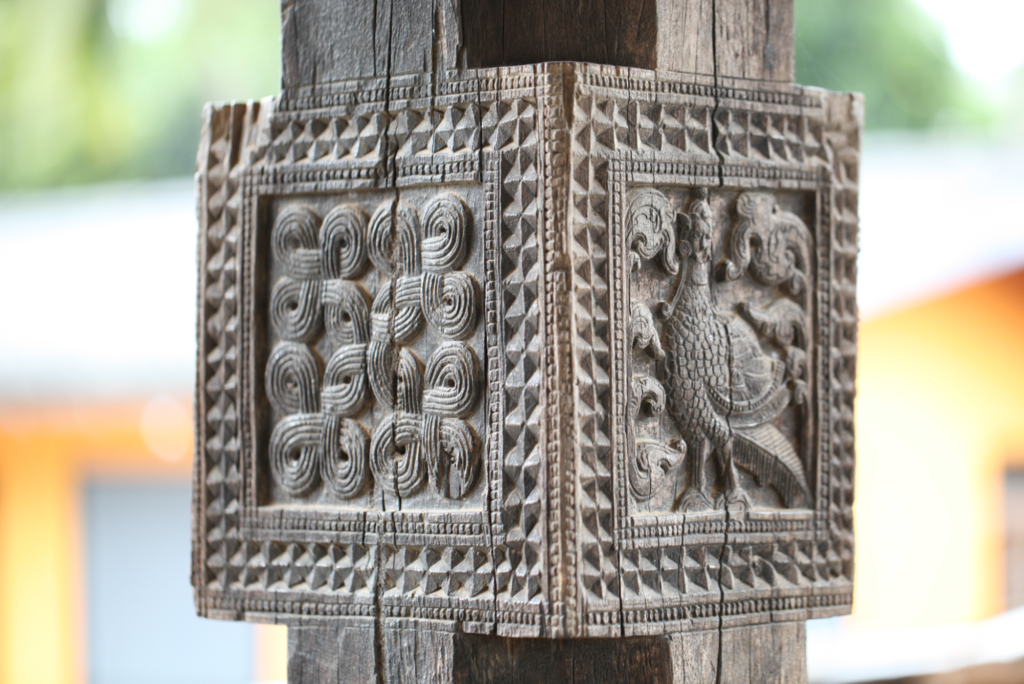

Embekke Wooden Temple
Embakke wooden temple, famed for its elaborate woodcarvings, pillars and other structures, note the wooden capital pillars which have assumed varied shapes moulded skillfully into these intricate wood carvings. The bottom square is octagonal with carvings, while its top terminates in a depiction of leaves emanating from a square. Once you passthrough the main entrance of the Ambakke, you will find the main hall with the carved wooden columns, also note the pillar and doorsimpressively decorated with wood carvings and also the ceiling was decorated with a special design. Take note that that they used wood for everything you see here, without any metal parts even the nails are made of wood. Decorations include flowers, swans, dancers, solders and lots of mythical animals. Among the carvings, there are 125 series of decorations, 256 liyawel, 64 lotus designs, 30 decorative patterns on timber roof joists or beams, making a total of 514 such exquisite carvings. This templewas also built in the 14th century and the roof was covered with flat tiles. Rope design, entwining swans,
dancing girls are some of the decorative creations found on these stone columns, somewhat akin to the woodcarvings at Ambakke. The villagers still remember the existence of this Ambalama with its wooden roof about 100 years ago.
- Central Province
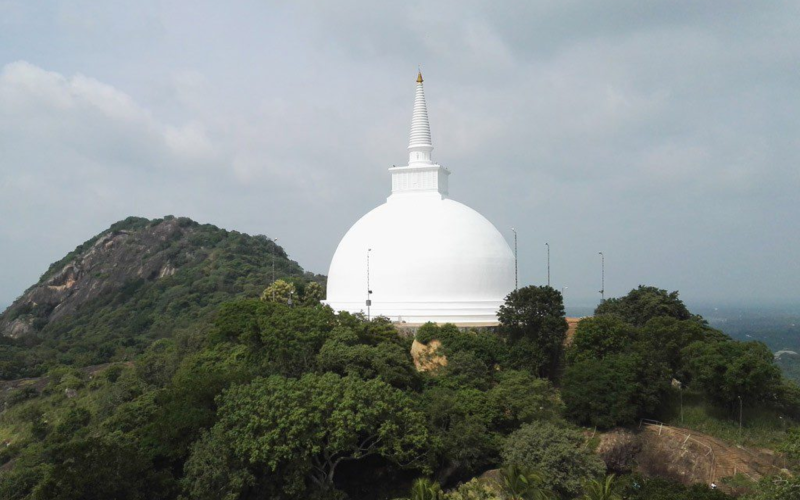

Mihintale Temple
Mihintale is a significant religious site located near Anuradhapura in Sri Lanka. It is considered one of the most important pilgrimage sites for Buddhists as it is believed to be the place where Buddhism was introduced to the island. According to legend, in the 3rd century BCE, the Indian Buddhist monk Mahinda, the son of Emperor Ashoka, converted King Devanampiya Tissa of Sri Lanka to Buddhism at this very location. This event marked the formal establishment of Buddhism in the country.
- North Central Province
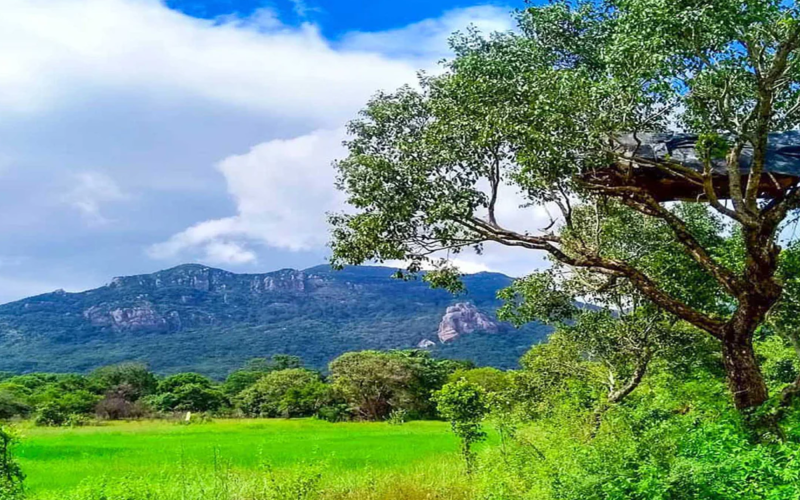

Ritigala Mountain
Ritigala is a mountain range and a historical site located in the Anuradhapura District of Sri Lanka. It is known for its lush forests, ancient ruins, and tranquil atmosphere, Mountain is known for its scenic beauty and abundant flora and fauna. The area is covered with dense forests, including tropical rainforests and dry-zone forests. The mountain range is home to a variety of plant species, including medicinal herbs and rare orchids.
- North Central Province
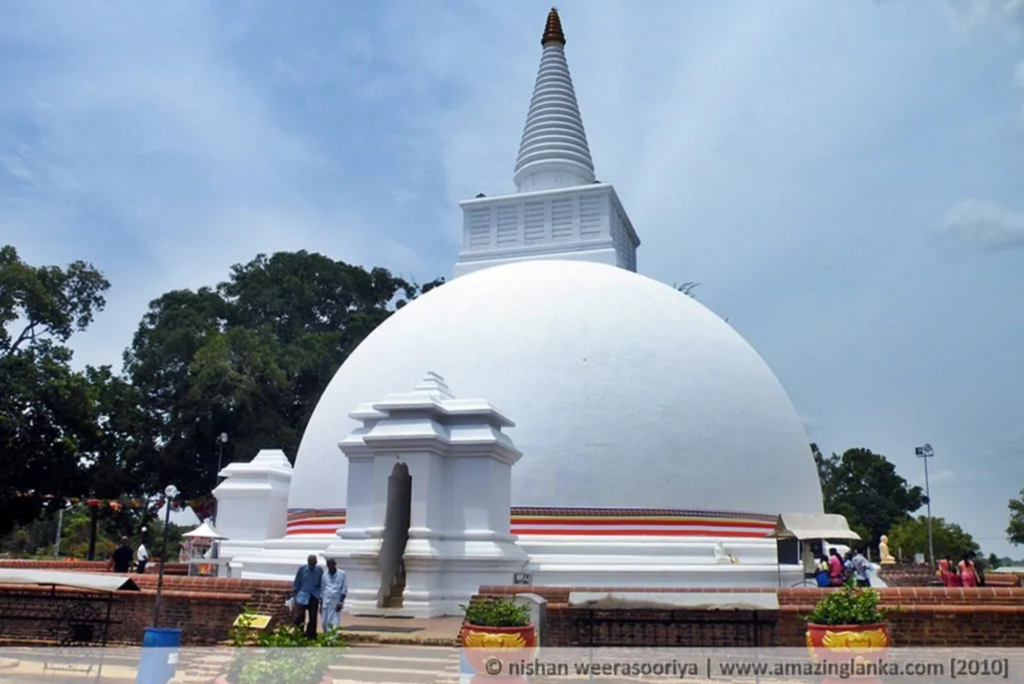

Somawathiya Temple
The Somawathiya Stupa is a significant Buddhist temple located in the Polonnaruwa District of Sri Lanka. The temple is believed to have been built during the reign of King Dutugemunu (161-137 BCE), a prominent ruler in ancient Sri Lanka. It holds great religious and historical significance for Buddhists in the country, believed to house a sacred relic of Lord Buddha, specifically a hair relic. This relic is highly venerated by Buddhists, and pilgrims visit the temple
to pay their respects and seek blessings.
- North Central Province
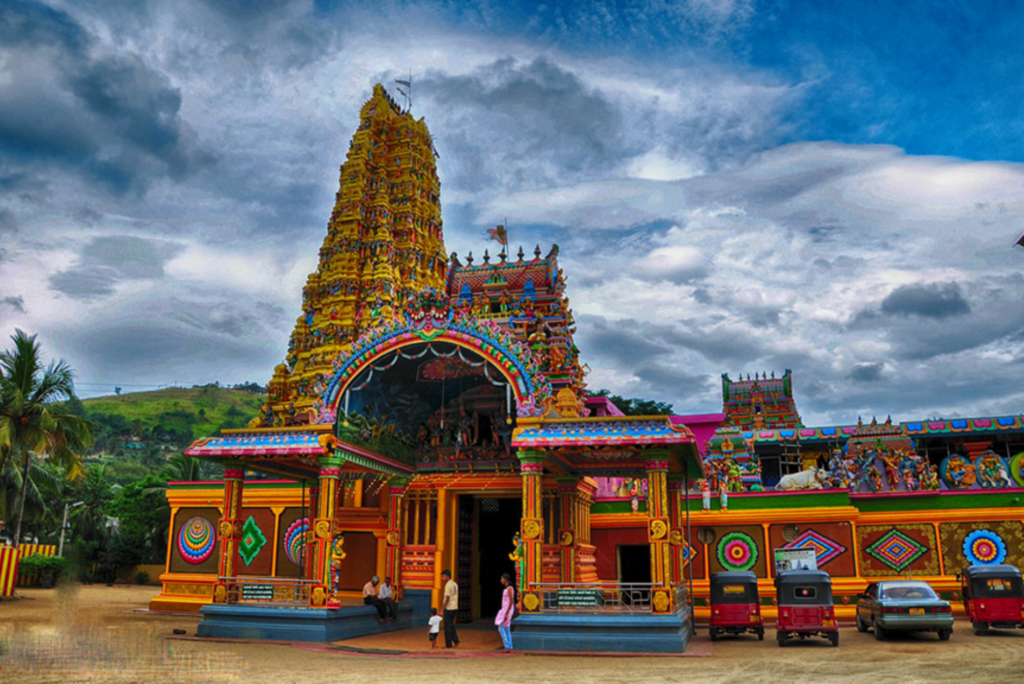

Matale Hindu temple
The Sri Muthumariamman Temple is dedicated to the goddess Mariamman, a popular deity worshipped by Tamil Hindus. The temple is located in Matale, making it easily accessible to visitors. Temple has a rich history and is considered a place of worship and cultural significance for the local Tamil Hindu community. It has been a focal point for religious and cultural activities for many years. Temple has a rich history and is considered a place of worship and cultural
significance for the local Tamil Hindu community. It has been a focal point for religious and cultural activities for many years. The temple features unique Dravidian-style architecture, which is characteristic of many Hindu temples in South India and Sri Lanka. It is adorned with
colorful sculptures, intricate carvings, and decorative motifs that depict various deities and
mythological stories.
- Central Province
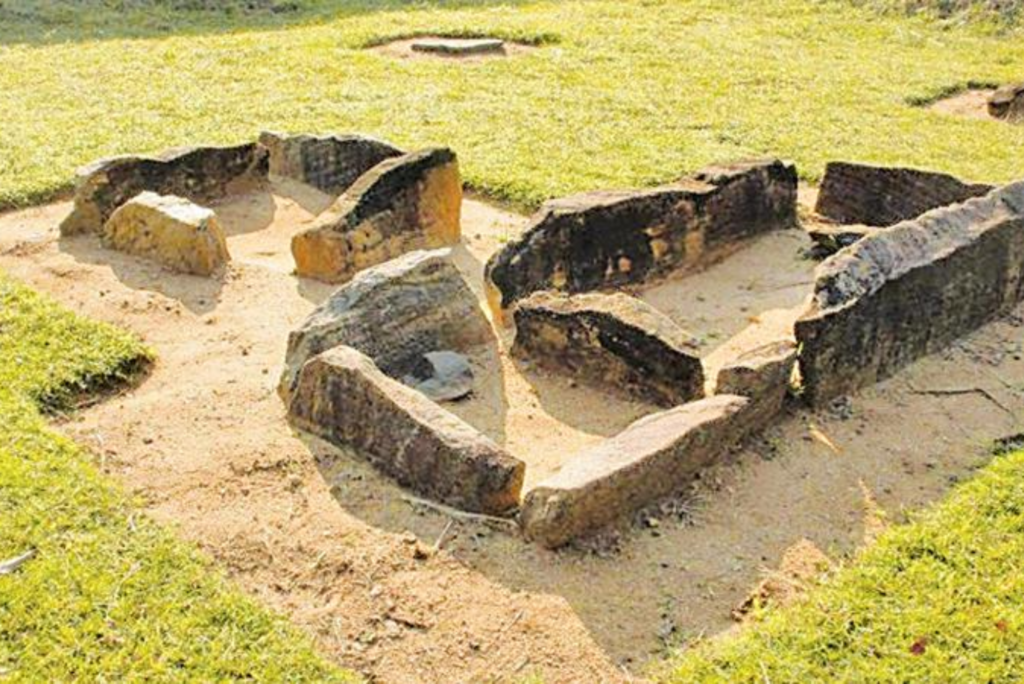

Ibbankatuwa Ancient Cemetery
The Ibbankatuwa Ancient Cemetery is an important archaeological site that dates back to the prehistoric period. Excavations conducted at the site have revealed evidence of human burials and associated artifacts. Cemetery complex at Ibbankatuwa consists of numerous circular and
rectangular burial mounds, or barrows, which are made of piled stones and earth. These mounds vary in size and shape, indicating different burial practices and possibly different social statuses of the individuals buried there.
- Central Province
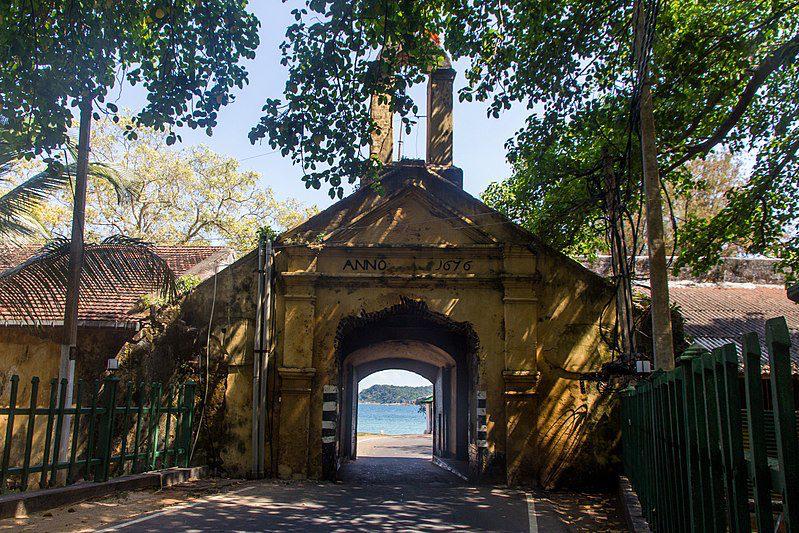

Fort Frederick
Fort Frederick is situated on a rocky promontory in the city of Trincomalee, on the northeastern coast of Sri Lanka. It overlooks the Trincomalee Bay and offers panoramic views of the surrounding area. The fort has a rich history that dates back to various periods of colonial rule. It was initially built by the Portuguese in the 17th century, later captured by the Dutch, and finally taken over by the British in 1795. The fort played a strategic role in the control of the Trincomalee Harbor.
- Eastern Province
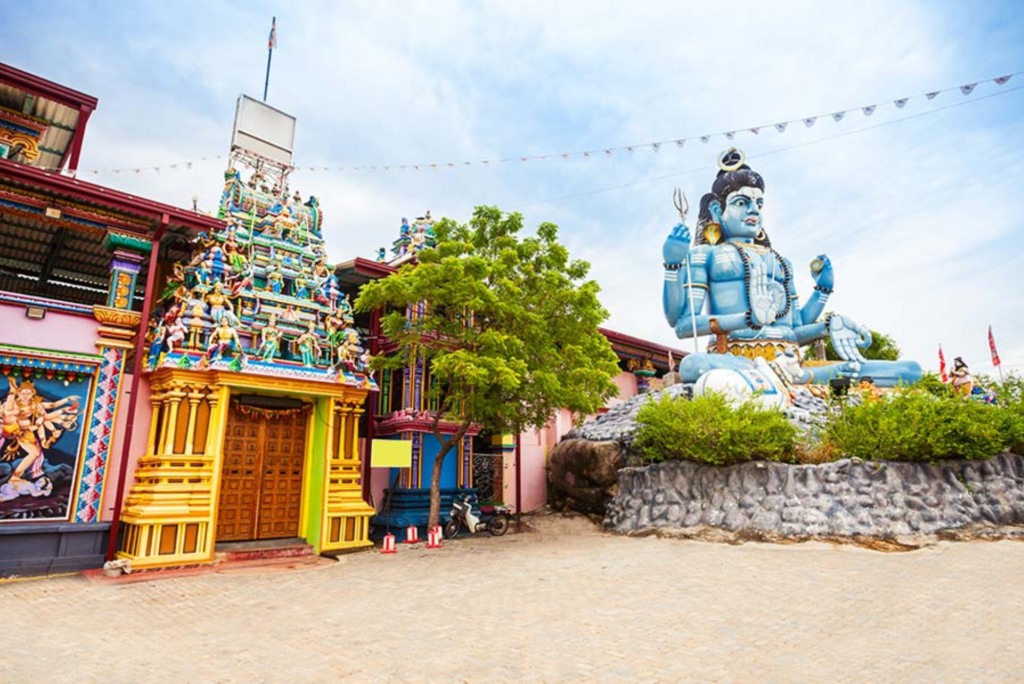

Koneswaram Temple
The Sri Muthumariamman Temple is dedicated to the goddess Mariamman, a popular deity worshipped by Tamil Hindus. The temple is located in Matale, making it easily accessible to visitors. Temple has a rich history and is considered a place of worship and cultural significance for the local Tamil Hindu community. It has been a focal point for religious and cultural activities for many years. Temple has a rich history and is considered a place of worship and cultural
significance for the local Tamil Hindu community. It has been a focal point for religious and cultural activities for many years. The temple features unique Dravidian-style architecture, which is characteristic of many Hindu temples in South India and Sri Lanka. It is adorned with colorful sculptures, intricate carvings, and decorative motifs that depict various deities and
mythological stories.
- Eastern Province
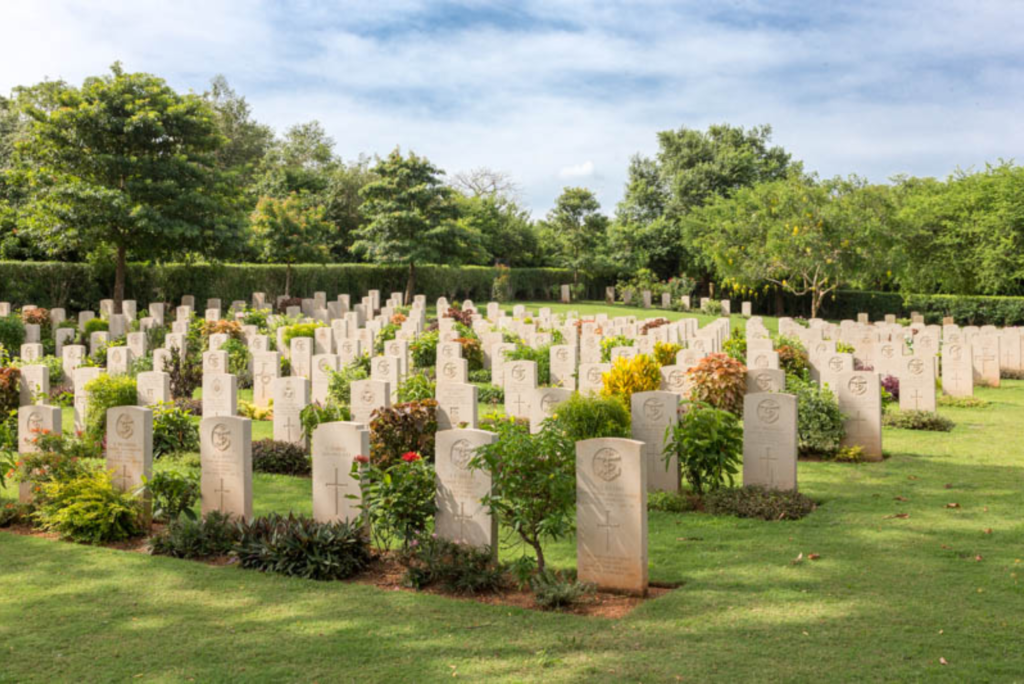

Trincomalee War Cemetery
War Cemetery was established during World War II. Trincomalee, with its strategic location, served as an important naval base for the Allied forces during the war. The cemetery was created to honor and commemorate the servicemen who lost their lives during the conflict. The war cemetery is located on Naval Hospital Road in Trincomalee. It is situated near the Trincomalee Harbor and offers a serene and peaceful environment for remembrance. Layout and Features: The cemetery is meticulously maintained by the Commonwealth War Graves Commission. It features rows of neatly arranged graves, each marked with a headstone or
memorial plaque. The graves belong to servicemen from various countries who served in different branches of the armed forces.
- Eastern Province
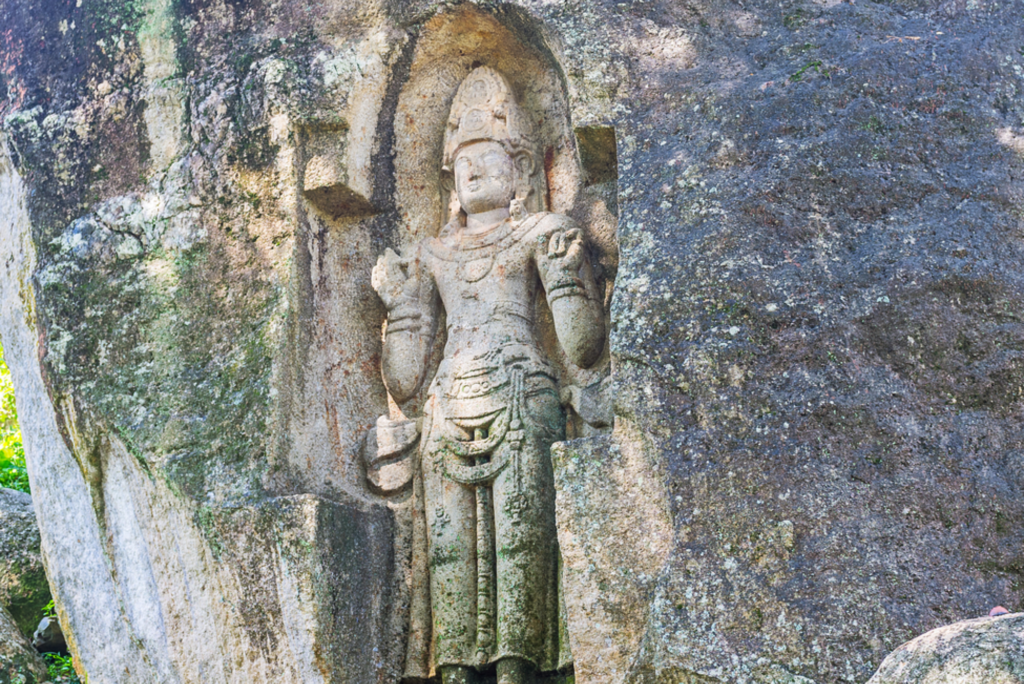

KustharajaGal
Kustharajagala is a large sculpture carved onto a granite rock face, and it depicts a standing Buddha figure. The carving is estimated to date back to the 9th or 10th century during the reign of the ancient Sinhalese kingdom of Ruhuna. The statue is approximately 40 feet (12 meters) in height, making it one of the tallest rock carvings in Sri Lanka. The unique feature of Kustharajagala is that it depicts a fusion of Mahayana and Theravada Buddhist traditions. The standing Buddha figure is believed to represent Avalokiteshvara, a bodhisattva associated with compassion in Mahayana Buddhism. However, the statue also holds attributes and poses commonly seen in Theravada Buddhism.
- Southern Province
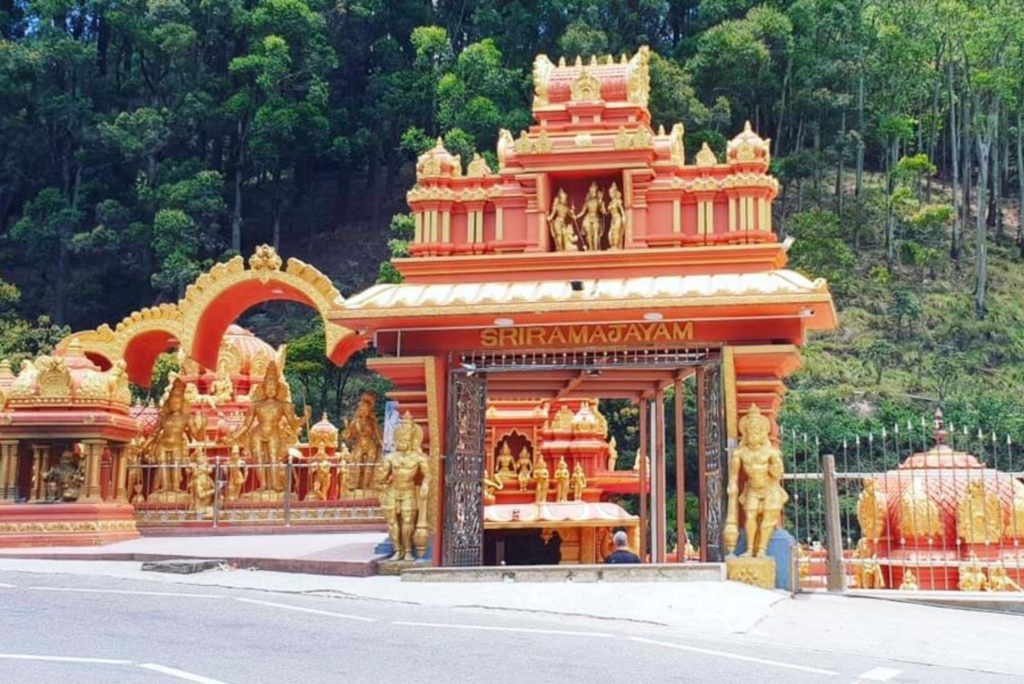

The Seetha Amman Temple
Known as the Sri Sita Amman Temple, is a Hindu temple located in the village of Seetha Eliya (or Sita Eliya) in the Nuwara Eliya District of Sri Lanka. It is a significant pilgrimage site for Hindus, particularly those who revere the Hindu epic Ramayana.
According to Hindu mythology and the Ramayana, Seetha Amman Temple is believed to be the spot where Sita, the consort of Lord Rama, was held captive by the demon king Ravana. The temple is said to be located in the vicinity of the Ashok Vatika, where Ravana is said to have held Sita captive.
- Central Province
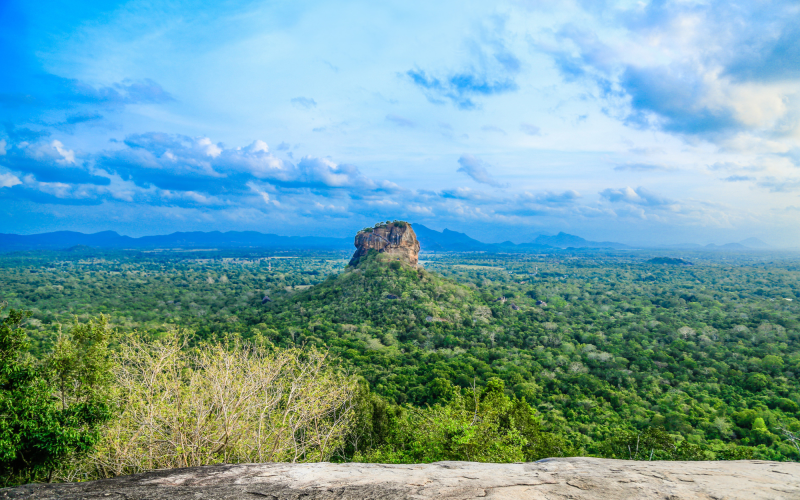

Pidurangala Rock Temple
Pidurangala rock temple built in the 5th Century A.D. spread over 13.5 acres; the monastery gave sanctuary to 500 meditating monks. The monastery was said to be ‘panchavasa’, complete with the five major ritual buildings, the Chapter House, Image House, the Bo tree, stupa and the Sangharamaya or Sabha for the monks. A flight of steps leads to the summit, where a long Natural cave centre of meditation chambers has been developed within the gigantic central rock. The huge 48 feet long reclining Buddha statue made out of brick, clay and lime is considered to be one of Asia’s oldest. When you reach the top of the rock you can get to see an amazing panoramic view of the rock fortress of Sigiriya.
- Central Province
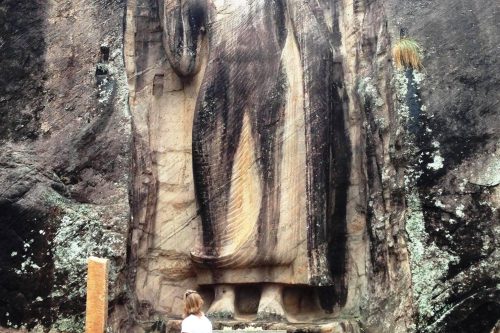

Raswehera Temple
Built by the king Devanampiya Tissa (307BC-267BC), Reswehera Rajamaha Vihara is an ancient temple situated in north western province in Sri Lanka. It is well known for its two Gautama Buddha statues and the Bo tree which was planted from a branch of the sacred Jaya Sri Maha Bodhi. One statue is carved in a rock while the other inside the vihara. There are 99 caves in the surrounding jungle where monks used to meditate.,There is a buddha statue which is similar to the ‘Aukana Buddha statue’, which has height about 13 meter. And there is a recline statue of Lord Buddha inside the shrine room of the temple which has about 36 feet length.
The rock on which the Buddha is carved isn’t always embellished and is simplest a rectangular block of stone and one ear is likewise left unfinished. Therefore, this statue is thought to be the “Rahera” statue which, according to chronicles
- North Western Province
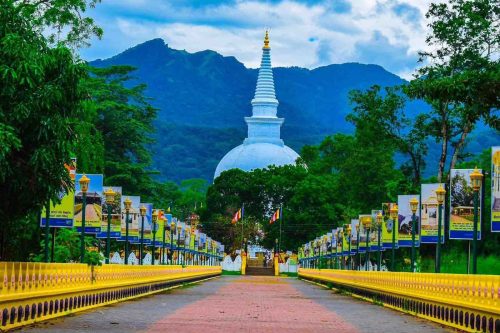

Mahiyanganaya Raja Maha Viharaya
Maiyangana Raja Maha Viharaya this temple is special because of the dagoba where the hair relics of the Buddha are kept. According to legend Prince Saman of the Deva tribe requested the Buddha for a token of presence that could be held high in reverence; thus he was granted a curl of hair from the Buddha’s head. The Prince enshrined the hair relic in the ancient Mahiyangana Stupa. Thus Mahiyangana became the first ever Stupa to be built in Sri Lanka.
The temple of Mahiyangana is a must visit as it boasts of a rich religious and cultural heritage and you can be a part of the rituals and practices carried out by the folk of the surrounding villages.
- Uva Province
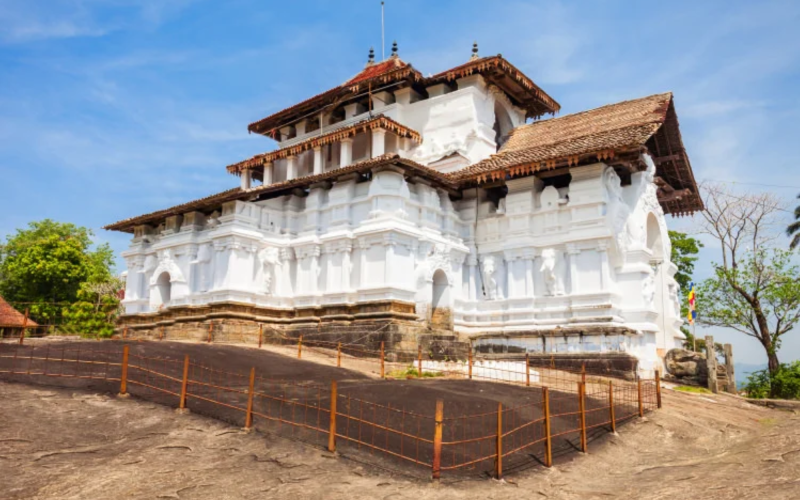

Lankatilaka Temple
Lankatilaka temple is a unique Buddhist temple built of stone, brick, and lime plaster.
Construction of this Temple began in the14th century, was of four stories, there are some
remains of an earlier construction on the uneven surface of the rock with a granite based foundation. The plan of the temple protrudes to the four sides like of a cross. What is seen today is the Ground Floor and part of the First Floor of the earlier temple although at some stage the temple seems to have had three stories. Now, all that remains of the temple is a section of the first floor covered with a tiled wooden roof. The notable main entrance which is in the form of the”dragon arch”, faces eastwards, and there is also a very beautiful view of the surrounding landscape seen from the stone stairway leading from the village.
- North Central Province
